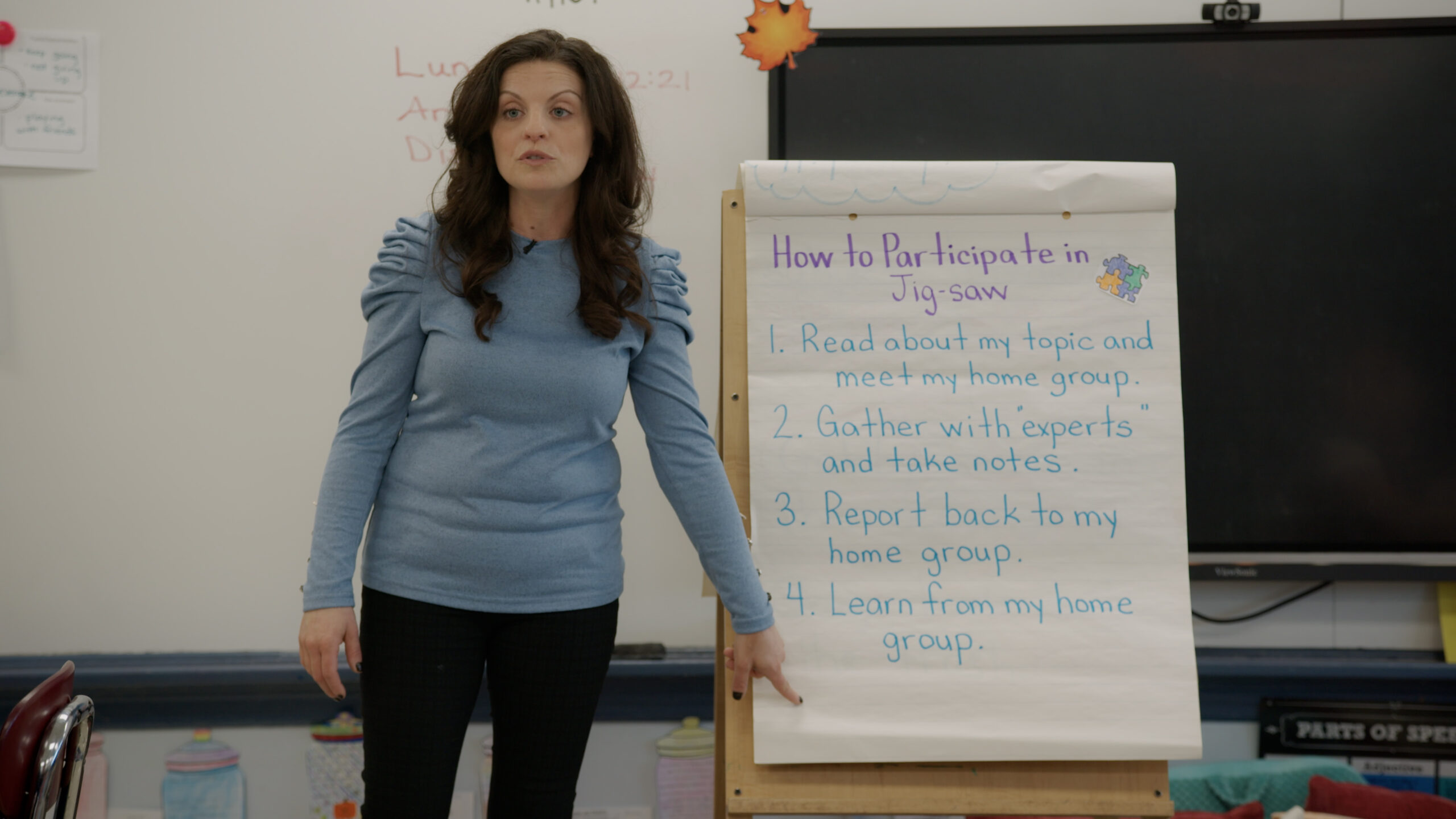Introducing Think Alouds through Sentence Starters
Overview
In this video, the teacher introduces and models think-aloud using the sentence starter “I’m getting the sense that…” with a familiar text during a class read. Students are prompted to practice the think-aloud strategy with partners and share their thinking with the group. Students are then encouraged to continue practicing during independent reading.
Key Take-aways
• Explicitly model think-aloud strategies to show how readers think during reading to support comprehension.
• Some think-aloud sentence starters include, “I wonder..” “ I’m getting the sense that..” and “I used to think but now I think..”
• Guide students in practicing thinking aloud with partners and using evidence from the text to support their ideas.
Transcript
Dr. Ken Kunz: In this video, Mrs. Namati not only defines what a think-aloud is, but also showcases how to skillfully incorporate this strategy across various types of texts. Forget the confusion. She clarifies what a think-aloud is versus what it is not. Join us as we discover how think-alouds become our secret weapon for understanding stories, learning new ideas, and solving those tricky reading puzzles.
Teacher: Today, we are going to think about what we’re reading in our minds. Think-alouds are like a magical window into the world of reading. I want you all to think about your favorite books. Think about your favorite books. You can even close your eyes while you think about them. Okay? Pretend you are reading it right now. Okay? As you read, you’re thinking about making connections, thinking about what’s happening. Everybody see it? Okay? Constantly, our brain is working like a little machine. While we’re reading a book. Today, we are going to read chapter four that says, Danger in the Deep. Okay? I am thinking about what that could mean. Danger in the Deep. I know that Eugenie loves fish. Okay, so maybe. What do you thinking might be happening? Think about it in your mind. What do you think might be happening? Just think about it. Okay? I’m getting the sense that maybe she’s going to swim in water. If it says danger in the deep. Okay, I am going to start reading and then we’ll figure it out. Okay. Everybody turned to page 24. Okay?
Teacher: In those days, people who wanted to explore the bottom of the sea had to wear heavy helmets with airlines that connected them to the boat above. Now, for the first time, Eugenie was going to walk on the sea bottom in a diving helmet. So we just read a little bit about danger in the deep. We’re going to stop right there. You’re going to turn and talk to your reading buddy, but when you think aloud, I want you to use the sentence starter, I’m getting the sense that. That’s how I want you to think about what might be happening in this chapter. All right? Can we all say that together?
Student(s): I’m getting the sense that.
Teacher: Okay, turn and talk to your reading buddies.
Teacher: Okay, come back to me. What are you getting the sense that might be happening, Emmanuel?
Student(s): Um, I am getting the sense that she’s going all way deep to see where the sharks are.
Teacher: Okay. Maybe Eugenie is going really deep into the ocean. Anybody else would like to share their thinking? Gino.
Student(s): I’m getting the sense that like, that, like she’s going to see a shark for the first time in her life.
Teacher: Danger in the deep. Maybe she’s going to see a shark for the first time in her life. Okay, let’s keep reading to find out more. Okay. Before you, Eugenie could go in the water, she had to have lessons. She had to learn how to turn the air valve on the helmet to control the amount of air she breathed.
Dr. Ken Kunz: Using a familiar text, the teacher demonstrates that think-alouds are like giving a play-by-play of our thoughts as we read, unraveling the mystery of what’s happening inside our heads.
Teacher: I’m getting the sense that Eugenie is in danger. Are you getting that?
Student(s): Yes.
Teacher: But her head felt groggy. Something was terribly wrong. She started toward the boat as fast as she could, but her steps were so slow. The helmet was so heavy. Now her breath was coming in short, gasps her eyes burned, her head felt numb.
Teacher: I want you to turn and talk, okay? Do your think-aloud with your reading, buddy. Go ahead. Remember we’re going to the sentence. I’m getting the sense that. Okay, come back to me. Who would like to share? Now remember, when you share, you’re going to use the sentence starter. I’m getting the sense that. Gabriela?
Student(s): I’m getting the sense in my head that she, that she’s in trouble and she might first see shark and then she might pull the rope 1, 2, 3, 4 times since she’s in danger because she needs breath.
Teacher: Yes. Very good. Why do you think think-alouds are important during reading? Talk to your reading buddies about it.
Student(s): They are important because you think.
Teacher: Okay, come on back to me. Okay, as you read today, when you’re doing your independent reading, I want you to try to think aloud. I’m getting the sense that. Okay?


